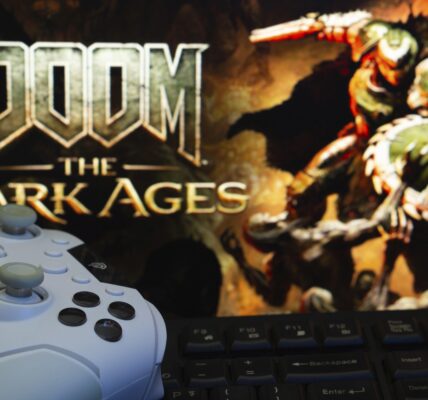Avowed—Obsidian’s first-person fantasy RPG set in the Pillars of Eternity universe—launched on February 18, 2025, after a delay to dodge 2024’s crowded release calendar. Despite landing in February’s chaos (Civilization 7, Monster Hunter Wilds), it carved a niche with its vibrant world and player-driven storytelling. Controversy swirled pre-launch: anti-DEI critics baselessly labeled it “woke” for diverse character designs and pronoun options, but the backlash fizzled faster than a campfire in a rainstorm. What stuck? A rich, reactive RPG where every mushroom-faced godlike hero or elven diplomat feels impactful.
How Avowed Expands the Eora Universe
Eora isn’t just recycled lore—it’s Pillars of Eternity’s soul, deepened. The Aedyr Empire’s colonial grip on the Living Lands clashes with local tribes, while animancy (soul manipulation) ties into the Wheel, a cosmic reincarnation system. Newcomers get crash courses via Obsidian’s Lore of Eora videos, explaining furry orlans, shark-like aumaua, and godlikes—beings marked by deities at birth. Your protagonist? A mystery-shrouded godlike, their antler-like growths hinting at divine favor (or curse). Forget Tolkien retreads; Eora’s gods are man-made soul constructs, and their lies unravel as you explore.
Essentially, we are entering a completely new universe. This universe offers us a glimpse of creatures never seen before. In addition, it comes with a story from one of the best-known RPG studios out there.
The Living Lands Unveiled In A World of Vibrant Wonders
Imagine Jurassic Park meets Alice in Wonderland. The Living Lands’ valleys shift ecosystems hourly—lush jungles boil into geyser fields, while storms flash-freeze lakes. You’ll navigate mushroom forests teeming with Pillars’ classic beasts (hello, adragan!) and new horrors, like acid-spitting flora. Two sprawling cities anchor the chaos: frontier outposts clash with Aedyr’s marble spires, each alley dripping with political tension. Pro tip: pack a raincoat. The real-time weather isn’t just pretty—it drowns visibility, so plan treks wisely.
The Living Lands are also home to mysterious ruins, remnants of ancient civilizations that hold secrets and dangers, adding another layer of exploration and discovery to your journey. Additionally, the island’s unique biomes are more than visually stunning. They are also metaphysically charged, reflecting the spiritual and mystical aspects of the Pillars of Eternity universe. This makes every step feel like uncovering a piece of Eora’s rich history.
The Role of the Protagonist in Avowed
You’re no chosen one. As a godlike, your powers (frost bursts, fire shields) draw awe and suspicion. NPCs cross streets to avoid you—or beg for blessings. Toggle your fungal face spikes off if you crave normalcy, but lean in: dialogue options shift based on your godlike status, unlocking intimidations or alliances. The catch? Your deity patron’s a mystery. Are you Eothas’ pawn or Woedica’s accident? Obsidian lets you—and the world—decide.
This dynamic also affects your relationships with other godlikes, who may view you as a rival or a potential ally based on your divine affiliations. Furthermore, your godlike abilities can influence the environment itself, allowing you to manipulate the world in ways that reflect your patron deity’s influence. This adds a layer of depth to your interactions with Eora’s landscapes and inhabitants.
The Freedom of Loadout Customization
Ditch Skyrim’s menu slog. Loadouts swap mid-fight: freeze archers with ice magic, then yank their leader into a sword flurry. Want a pistol-slinging druid? Go wild. Combos feel weighty—chain lightning into poison pools, then watch foes melt into goo. It’s not perfect (aiming spells feels floaty), but the flexibility rewards creativity. Think Dishonored meets Dragon Age, minus the pause screens.
This system encourages experimentation by allowing players to mix and match any weapons or defensive objects in their hands, creating unique loadouts that can be switched seamlessly during combat. The loadout system also helps manage stamina and Essence consumption, making combat more strategic and efficient. Additionally, Avowed forgoes traditional class limitations, allowing players to invest in all skill trees simultaneously, further enhancing the customization and flexibility of their builds.
The Voice in Your Head and Navigating the Mysteries of the Adra
The Adra—glowing crystals housing souls—whisper plot twists. One bonds to you, its motives murkier than swamp water. Is it a trapped Engwithan sage or a god’s puppet? Your choices here ripple: side with animancers dissecting Adra or smash them to “free” souls. Lore hounds, rejoice: this ties into Pillars’ Hollowborn crisis, where soulless births plagued nations. Ignore the Adra, and you’ll miss Eora’s heartbeat.
Finding Strangled Adra, a unique type of Adra covered in vines, allows you to commune with the mysterious voice in your head. This offers deeper insights into the world of Avowed and its lore. These interactions can reveal fragments of Eora’s history and the role of the Adra in the spiritual fabric of the world, making them crucial for understanding the game’s narrative. Additionally, Adra’s presence is central to the game’s themes of soul manipulation and the ethical dilemmas surrounding animacy, adding depth to your character’s journey.
Dreamscourge and Deception As the Plot of Avowed
The Dreamscourge plague melts minds into nightmares, and the Aedyr Empire’s “aid” smells fishier than a week-old catch. Uncover their lies while juggling factions: back tribal rebels for guerrilla perks, or exploit imperial resources and risk mutiny. Betrayals sting, and “good” choices often backfire—saving a village might doom another. It’s Game of Thrones with more mushroom people.
As you delve deeper into the Dreamscourge, you’ll encounter various factions vying for power, each with their own agendas and motivations. The Aedyr Empire seeks to assert control over the Living Lands, while local tribes resist their rule, leading to a complex web of alliances and rivalries that you must navigate. Your decisions will influence not only the fate of the Living Lands but also the balance of power within the empire itself, making every choice feel like a gamble with unpredictable outcomes.
“Not Just Another Skyrim Clone” – What Sets Avowed Apart
Yes, it’s first-person with swords. But Avowed swaps Skyrim’s buffet-style exploration for a curated seven-course meal. The Living Lands’ biomes feel handcrafted, not procedurally generated. While your godlike’s identity shapes interactions more than Dragonborn shouts ever could. Combat’s faster, politics messier, and the lack of mod support (for now) forces you to savor Obsidian’s vision—quirks and all. Unlike Skyrim, Avowed focuses on a more intimate, story-driven experience. Your character’s background as an envoy from the Aedyr Empire influences NPC interactions and quest outcomes.
Additionally, Avowed’s combat system allows for a wide range of customization. Combining magic and melee in unique ways that feel distinct from Skyrim’s more straightforward combat mechanics. The game’s emphasis on choice and consequence also adds a layer of depth. This makes every decision feel impactful in a way that diverges from the more open-ended exploration of Skyrim.
A Visual Feast with Some Flaws
Artistically, it’s stunning: luminescent caves, godlike designs oozing fungal charm, and cities dripping with lore. Technically? Hitches haunt Xbox Series S, with texture pop-in and frame drops during storms. The delay clearly prioritized polish on high-end PCs, leaving consoles nibbling scraps. Still, it’s Obsidian’s prettiest game—just don’t pixel-peep. The art style, reminiscent of The Outer Worlds, brings a vibrant realism that feels modern without striving for hyper-realism. This aligns well with Obsidian’s design philosophy of balancing visual appeal with gameplay focus.
Despite some technical issues, the game’s visuals are reinforced by its use of color. This creates environments that feel distinct and immersive, even if they don’t push the boundaries of next-gen graphics. Additionally, the key art for Avowed reflects this artistic vision. This is done by blending traditional and abstract elements to capture the game’s essence in a unique way.
The Depth of Storytelling In Avowed
Kill a traitor, and their sibling ambushes you later. Spare them, and they might fund your rebellion. Every major quest forks, with endings ranging from bittersweet to catastrophic. Even side characters remember snubs—ignore a beggar, and they’ll heckle you in the next town. New Game+ tempts with harder choices, but one playthrough’s 25-hour ride feels meaty enough. The game’s reputation system furthers the depth of these consequences. It tracks your actions and influences how NPCs perceive you, affecting everything from shop prices to quest availability.
Additionally, the branching narratives are designed to encourage replayability. Each choice can lead to drastically different outcomes. This makes Avowed a game that rewards exploration of its multiple story paths. Furthermore, the game’s focus on player agency means that even seemingly minor interactions can have long-term effects, adding a layer of realism and immersion to the world of Eora.
Avowed isn’t for everyone. Loot addicts will crave more gear and performance hiccups sting. But for RPG fans craving New Vegas-esque depth in a fantasy skin, it’s a must-play. The Living Lands’ chaos, godlike roleplay, and branching stories outshine February’s rivals. Clear your backlog? Maybe not. But make room? Absolutely. Despite its technical issues, Avowed offers a rich narrative experience that Obsidian fans will adore, with a world that’s both visually stunning and lore-dense. The game’s compact runtime and replay value make it an excellent choice for those seeking a focused RPG experience without the overwhelming length of some modern epics. Additionally, Avowed’s emphasis on player choice and consequence ensures that each playthrough feels unique, making it a compelling addition to any RPG enthusiast’s library.




